Elkonin Sound Boxes: What They Are & How to Use Them
Phonemic awareness serves as the foundation for a child’s journey into the world of literacy, and Elkonin boxes offer a powerful tool for nurturing this crucial skill. In this post, we will explore Elkonin boxes (AKA sound boxes), their significance in phonemic awareness instruction, and how educators can leverage them to expedite the critical in-the-brain word-learning process, referred to as orthographic mapping.
What Are Elkonin Boxes?
Elkonin boxes, named after the Russian psychologist D.B. Elkonin, are a visual tool designed to support phonemic awareness and strengthen children’s understanding of the alphabetic principle. This series of connected boxes – drawn with one cell for each sound (not each letter) in a word–provides a structured framework for students to locate, visualize, and manipulate the phonemes that make up a particular word.
Are Elkonin Boxes and Sound Boxes the Same Thing?
Yes! Sound boxes and Elkonin boxes are synonymous. The name sound boxes refers to the fact that each box represents a single sound in the word. Although children may begin by simply pointing to the corresponding box while saying the sounds or pushing some kind of object, such as a token or a block, into each cell as they say each sound, sooner rather than later, we want to get students writing the letters (k, s, t) or letter combinations (ck, ss, ed) in the boxes that represent the corresponding phoneme. The sooner we bring letters into phonemic awareness instruction, the better off students will be.
Here are some other terms that relate to sound boxes (Elkonin boxes). These aren’t labels for the tool but terms that are often used to describe ways to use the tool:
- Aligning sounds and spellings
- Orthographic mapping Mapping words
- Phonemic awareness
- Making the abstract concrete
- Segmenting
- Blending High-frequency words
- Sight words
- Automatic word reading
- Alphabetic principle
Regardless of what you call them, these boxes are used to help children hear the sounds in a word in order. In this post, we will use the two terms, Sounds boxes and Elkonin boxes, interchangeably.
Why Are Elkonin Boxes, or Sound Boxes, Important?
Phonemic awareness is a fundamental skill that precedes and predicts a child’s success in reading and spelling. In fact, without phonemic awareness, you never would have learned to read. But it’s hard for the human brain to hear the individual sounds in words, especially because of the many sounds within a word that run together. Elkonin boxes can play a helpful role in helping students develop awareness of phonemes across words by offering a tangible, visual, and linear representation of the sounds and their position across the word.
Their magic lies in engaging students in multi-sensory interactions with each “sound” in a word while simultaneously pronouncing those sounds. Making phonemes, which are invisible, visible by using things like teddy bear counters, Unifix blocks, or macaroni noodles, promotes phonological skills and paves the way for improved decoding (reading) and encoding (writing). Of course, as soon as possible, you will replace the generic sound markers in each box with the actual letters or groups of letters (graphemes) that represent each sound.
Try it Yourself with These Elkonin Boxes Printable Resources
To make it easy to give Elkonin boxes a try, we’ve made a printable resource for you to download. This resource is a PDF of sound boxes in a few different variations so that you can meet the diverse learning needs of your students.
Our printable Sound Box templates put this powerful tool at your fingertips so you can explore the adaptability of sound boxes for engaging your students in different kinds of phonemic awareness tasks.
How to Use Elkonin Boxes
Orthographic mapping (Ehri, 2014) is essentially alignment work. It is the brain making sense of, or proving, how the sounds in a spoken word (phonemes) match up with the series of spellings in the same word (graphemes).
So, if orthographic mapping is truly an “in-the-brain process,” how can we support this in the classroom to set the reading brains of young children up for success with this internal process?
Sound boxes are one of the best tools we know of, our go-to for scaffolding orthographic mapping. The beauty of sound boxes is that they provide a concrete tool for communicating and reinforcing what can otherwise be very abstract work.
In the numbered list below, we offer four simple but powerful steps for using Elkonin boxes to scaffold orthographic mapping from the OUTSIDE to increase the likelihood that it happens on the INSIDE! We demonstrate this series of steps using the word sheep.
So, here’s how you can put sound-spellings in their place!
1. Decide how many boxes are needed. To get started, simply provide or create a long, rectangular box and divide it into the number of sub-compartments that matches the number of individual sounds in the word. So the word sheep needs three sections for its three sounds, or phonemes (/sh/ /ē/ /p/).
2. Put one grapheme in each box. Now you’re ready to use one box to hold the grapheme for each phoneme in the word. We sometimes describe Elkonin boxes to children as a house with multiple rooms; each room gets one sound. Of course, some sounds are represented by graphemes that have more than one letter, such as the /sh/ sound in sheep. When one sound is spelled with two (or more) letters, then all of the letters in the grapheme go into the same box or room. In the example below, you can see that sheep has two sounds that are spelled with graphemes that have more than one letter. In the first box, the S and the H are roommates, representing the single sound /sh/. And in the middle box, the letters E and E are roommates, spelling the single sound /ē/
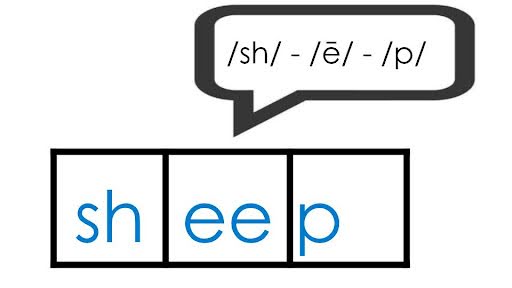
3. Carefully analyze the alignment. Support students in blending the sounds and noticing the way the individual sounds match up with their individual spellings. This alignment work glues the sound-spellings—in their meaningful sequence—to the matching sequence of the individual sounds in the spoken word. And this is how words are stored in the reading brain, so this is the critical work that helps lock the word into memory.
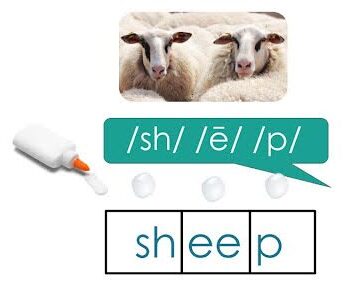
4. Write the word outside the boxes. To seal the deal, have children pull the word back out of the boxes and write it for themselves. Writing it a few times – referring to the sound boxes and saying the sounds as they write the letters or letter combinations (graphemes). This careful attention to the sounds that go with each grapheme really supports getting the word stored in memory. You can have children write the word a couple of times while sound-saying and using the sound box as a support. And then have children write it again–still sound-saying–but from memory.
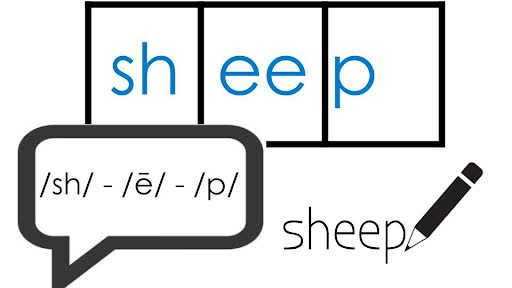
Elkonin boxes are a versatile tool with countless applications in the literacy classroom. For instance, they can be used to:
- Enhance phonemic awareness instruction.
- “Three sounds in sheep, so three sound boxes. Touch each of the boxes as you say the sounds in sheep.”
- Scaffold word learning.
- “The word sheep has three sounds but five letters. Let’s think about (look at) how the sounds and spellings match up.”
- Support students who are trying to work out the spelling of a word.
- “You’re trying to spell sheep? How many sounds do you hear? Right, three. So let’s make three boxes. Now, touch each box as you say the sounds again. What spellings do you expect for the first, middle, and last sounds in sheep? Write them in the boxes.”
Elkonin Box Examples
Okay, so let’s think about some specific words and how they would be “mapped” using sound boxes, moving from simple to more complex.
The word cat has 3 phonemes, or sounds—/k/ /a/ /t/. So, if we need three boxes to map the sounds in the word cat.

If students aren’t yet using letters, they can simply touch the boxes, one at a time, as they say the sounds, moving left to right, just as they would if they were reading.
Once they’re ready to add spellings, one spelling goes in each box, demonstrating that there is a one-to-one match between the sounds in a word and the spellings that represent them. This idea that the sounds and the spellings always align in a word is what is referred to as the alphabetic principle.

So, that seems pretty straightforward, right?
Of course, English has other spelling patterns that are not so straightforward. For instance, the word cash also has three sounds (phonemes), but the last sound is spelled (grapheme) with two letters that work together to represent just one sound, which is referred to as a consonant digraph. Once again, when using Elkonin boxes, you need three boxes to represent the word. So, the word cash would be mapped into sound boxes like this.

And the word stash would require a different kind of consideration. It actually has four sounds. Even though we think about the letters S and T together as “a blend,” we can still hear each of the individual sounds in that blend–/s/ /t/– when we listen carefully. So, stash has four sounds and would be mapped like this.

Sometimes words have silent letters, but they still get included in the sound boxes. For instance, lamb has just three sounds–/l/ /a/ /m/–and three graphemes, even though it has three letters. To map the word lamb into Elkonin boxes, the M and the B share a box because they represent just one phoneme, as shown below.

Of course, English has a deep orthography, meaning it has some complex and interesting spelling patterns that take extra thought. We teach how to handle some of these quirkier spellings in our online class and in the Sight Word Success Mini-Course.
So, you get the idea, right? To sum up, here’s a basic process for using Elkonin boxes:
- Listen for the number of sounds in a word.
- Draw or select the number of sound boxes that match the number of sounds in the word.
- Align the sounds (phonemes) and spellings (graphemes) by pointing to each sound box as you say the sound in that position in the word.
- Instead of pointing to an empty box, you can use objects or spellings to represent each sound in order.
Now it’s your turn. Below, we’ve made a list of words. Your job is to think about how many sounds you hear in each of them. When you’re ready, you can check your work here, where we use sound boxes to show how the sounds and spellings of these words align. So, read through the list of words, work to decide how many discrete sounds you hear in each of them, and then draw out some Elkonin boxes for yourself so that you can “map the sounds.”
- and
- them
- spy
- should
- knock
- taught
English is interesting, isn’t it? The deep orthography of English means that, just because the words above all have three sounds, they don’t necessarily all have three letters. In fact, a three-sound word can have a lot more than three letters!
And that’s actually part of the magic of these little boxes. Elkonin boxes clarify the relationship between sounds and spellings, helping the brain make sense of how 6 or 7 letters can represent just 3 sounds. By using sound boxes to map the individual sounds/phonemes in a word and align them to their spellings, we not only help children understand how English spellings work, but we also make it easier for their brains to remember those spellings.
4 Important Tips for Maximizing the Use of Elkonin Boxes
Once you get comfortable with sound boxes, you’ll find dozens of ways to use them across the learning day, from phonemic awareness instruction to shared writing to teaching high-frequency words. There are four primary ways that we use sound boxes to maximize word recognition instruction in any grade. Use soundboxes to:
- Establish and strengthen understanding of the alphabetic principle.
Alphabetic principle is the understanding of the reciprocal relationship between sounds and spellings, beginning with the most straightforward CVC words with 1-1 sound-spelling correspondence (cap, wet, got) and gradually moving to words with increasingly complex sound-spellings (sheep, shake, shown). - Help students analyze a surprise spelling.
When words have surprising or hard-to-understand spellings (said, does, thought), sound boxes are a tool for helping students make sense of the unexpected. We’ve developed classroom instructional materials and a two-hour, on-demand class about how to use Elkonin boxes as one component of teaching irregularly spelled words (words with surprise spellings) in ways that REALLY STICK! You can learn more here. - Assist students in thinking about the spelling of an unknown word.
It’s sometimes hard to know how to respond when a student asks, “How do you spell ____?” But sound boxes equip you with a concrete and effective tool for scaffolding the spelling of unknown words. By starting with the question, “Well, how many sounds do you hear in the word? Okay. Let’s make ___ boxes and see if we can figure out how to represent each of them.” - Provide practice (or review) of a newly taught (or previously taught) spelling pattern.
After you teach a new sound-spelling – especially a grapheme with more than one letter (i.e., sh, th, ch, ee, ou, -igh, etc.) – sound boxes provide the chance to reinforce the new sound-spelling. Helping students look (and listen) for the alignment between the sound and spelling for that digraph as part of a larger word will help them remember it.
Using Elkonin boxes to help students see the ways sounds and spellings align serves as a starting point as you work to make word learning really sticky for students. In fact, aligning sounds and spellings in words, referred to as orthographic mapping, is the necessary pathway for the human brain to truly learn a lot of words. In fact, every word you have learned to read and write automatically, you learned by aligning the phonemes and the graphemes in the word, whether you realized it or not.
And, because your life as a teacher is so busy, we wanted to create some resources that could help you implement this alignment work using Elkonin boxes TOMORROW. So, we made
The Sight Word Success (SWS) Classroom Materials a shortcut for you to maximize your planning time. The Lesson Guide offers step-by-step guidance and lesson plans for each of the 109 power words, and the Flipbook slideshows are already created for you to use in front of students. You can read more about the SWS Classroom Materials here.
Whether you call them Elkonin boxes or sound boxes, the tool we’ve explored in this post serves as a dynamic resource for fostering phonemic awareness as young readers work to establish a firm grasp of how our alphabetic system works. Elkonin boxes also serve as a source of clarity for beginning readers trying to make sense of English spellings. By confirming the relationship between sounds and spellings in unfamiliar words, both those that are predictably spelled (regular) or words with surprise spellings (irregular), sound boxes make the abstract work of breaking spoken language into individual sound bits (phonemes) both concrete and memorable. If you regularly incorporate these multi-sensory tools into your instructional practices, you’ll make learning to read easier – rather than harder – for the children you serve.
In the meantime,
fun with sound boxes!
References
Linnea C. Ehri. 2014. Orthographic Mapping in the Acquisition of Sight Word Reading,
Spelling Memory, and Vocabulary Learning, Scientific Studies of Reading, 18:1, 5-21. https://registrar.ecu.edu/wp-content/pv-uploads/sites/257/2019/07/ehri.pdf
Elkonin, C. (1973). Methods of teaching reading. In J. Downing (Ed.), Comparative reading: Cross-national studies of behavior and processing in reading and writing (pp. 551-579). New York: McMillan.

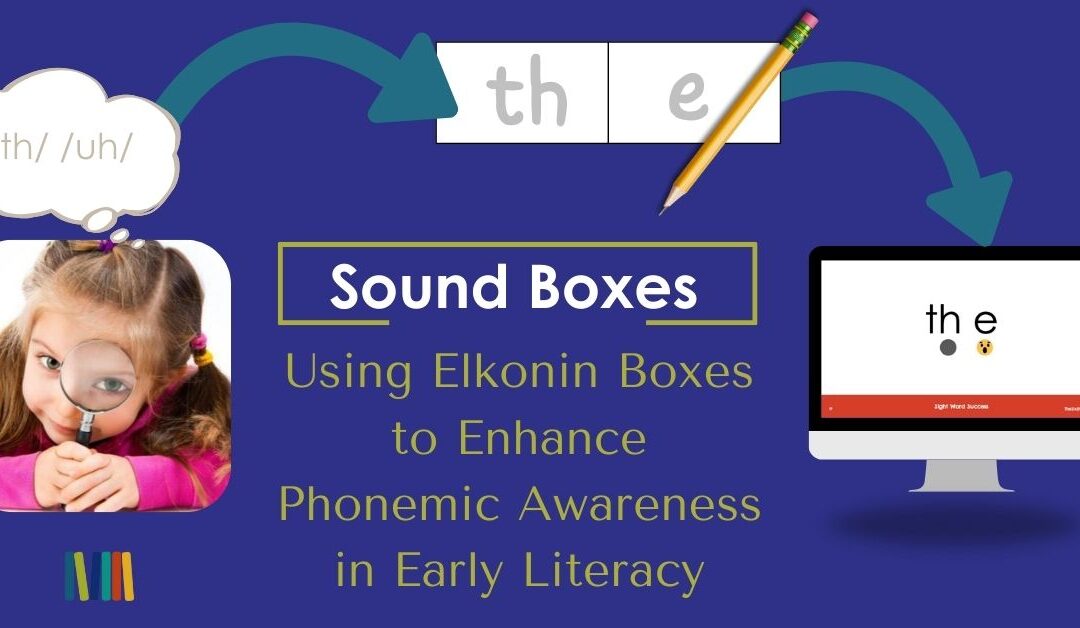


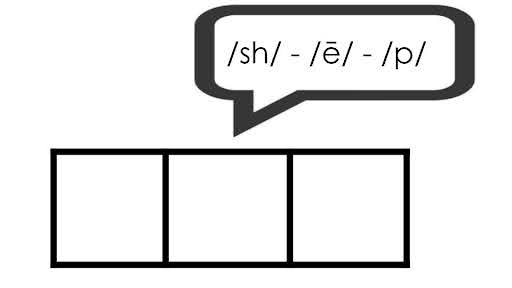
Recent Comments